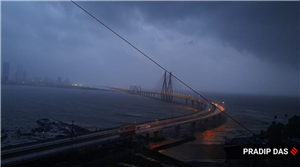The weather bureau forecast light to moderate rain along the Konkan coast – Sindhudurg, Ratnagiri, Raigad, Mumbai and Thane districts, while Palghar is very likely to record heavy rain at isolated places on Tuesday.
The India Meteorological Department (IMD) has forecast the rain and wind intensity to reduce by Tuesday as “severe cyclonic storm” Tauktae skirted the Maharashtra coastline on Monday and moved towards south Gujarat coast.
The weather bureau forecast light to moderate rain along the Konkan coast – Sindhudurg, Ratnagiri, Raigad, Mumbai and Thane districts, while Palghar is very likely to record heavy rain at isolated places on Tuesday.
As per the 48-hour forecast, issued by the IMD at 8 pm, Mumbai will witness a generally cloudy sky with moderate rain accompanied with gusty winds reaching 40-50 kmph gusting to 60 kmph. There is a possibility of heavy rainfall in isolated places. The minimum temperature is forecast to be below normal in the city at 25 degrees Celsius.
In 24 hours ending at 8.30 am on Monday, Sawantwadi in Sindhudurg district recorded extremely heavy rain at 370mm, followed by Ratnagiri at 360mm. Areas in Ratnagiri and Sindhudurg districts recorded rainfall above 150mm between Sunday and Monday morning. Total 11.9mm of rain was recorded in Mumbai in 24 hours, ending at 8.30 am on Monday.
Cyclone Tauktae (pronounced Tau-Te), rapidly intensified on Sunday and was classified as an “extremely severe cyclonic storm” (ESCS), which has a wind range of 166-221 kmph. It is likely to hit southern Gujarat on Monday night.
As of 5.30 pm on Monday, Tauktae’s location was over 195 km west-northwest of Mumbai and 80 km south-southeast of Diu. As per the forecast, Tauktae will cross between Porbandar and Mahuva in Gujarat’s Bhavnagar district, as a “very severe cyclonic storm” with an expected wind speed of 155-165 km/hour gusting to 185 km/hour. Tauktae has been intensifying rapidly. From a depression formed in the southeast Arabian Sea on May 14 morning, it strengthened into a VSCS by the early hours on Sunday and by late night, it developed into an ESCS. In the Arabian Sea, cyclones develop over Lakshadweep and traverse westwards or away from India’s west coast. However, in recent years, meteorologists observed that the Arabian Sea, too, has been warming.
Source: Read Full Article


